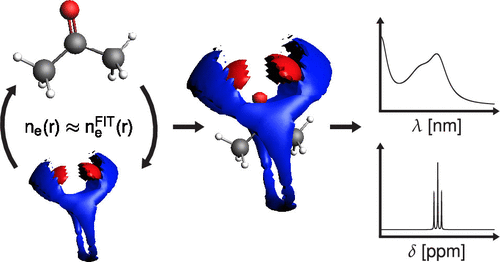当前位置:
X-MOL 学术
›
J. Phys. Chem. A
›
论文详情
Our official English website, www.x-mol.net, welcomes your feedback! (Note: you will need to create a separate account there.)
Evaluation of an Efficient 3D-RISM-SCF Implementation as a Tool for Computational Spectroscopy in Solution.
The Journal of Physical Chemistry A ( IF 2.9 ) Pub Date : 2020-08-24 , DOI: 10.1021/acs.jpca.0c06322 Marc Reimann 1 , Martin Kaupp 1
The Journal of Physical Chemistry A ( IF 2.9 ) Pub Date : 2020-08-24 , DOI: 10.1021/acs.jpca.0c06322 Marc Reimann 1 , Martin Kaupp 1
Affiliation

|
The 3D-RISM-SCF solvent-model implementation of Gusarov et al. [ J. Phys. Chem. A 2006, 110, 6083−6090] in the Amsterdam density functional program has been improved and extended. In particular, an accurate yet efficient representation of the solute electrostatic potential is provided. The Coulomb-potential fitting of many DFT codes can be used advantageously in this context. The extra effort compared to a point-charge representation is small for a given SCF cycle and compensated by faster SCF convergence. This allows applications to large solutes, as demonstrated by evaluation of the solvatochromism of Reichardt’s dye. In general, TDDFT applications to excitation energies in solution stand out and are highlighted. Applications to the 17O NMR chemical shifts of N-methylformamide in different solvents also demonstrate the distinct advantages of 3D-RISM over continuum solvents. Limitations are observed in this case for water solvent, where the solvent shielding is overestimated. This shortcoming applies also to the 17O gas-to-liquid shift of water, where we used localized molecular orbital analyses for a deeper understanding. For such cases of extremely strong solute–solvent interactions, couplings between solute and solvent orbitals induced by the magnetic perturbation are relevant. These clearly require a quantum-mechanical treatment of the most closely bound solvent molecules. Except for such extreme cases, 3D-RISM-SCF is very well suited to treat solvent effects on NMR parameters. More serious limitations pertain to the treatment of vibrational spectra, where the absence of the coupling between solute and solvent vibrational modes limits the accuracy of applications of 3D-RISM-SCF. The reported extended, efficient, and numerically accurate 3D-RISM-SCF implementation should provide a useful tool to study chemical and spectroscopic properties of molecules of appreciable size in a realistic solvent environment.
中文翻译:

评估作为解决方案中计算光谱工具的高效3D-RISM-SCF实施方案。
Gusarov等人的3D-RISM-SCF溶剂模型实现。[ J. Phys。化学 甲 2006,110在阿姆斯特丹密度泛函程序,6083-6090]进行了改进和延长。特别地,提供了对溶质静电势的准确而有效的表示。在这种情况下,可以有利地使用许多DFT码的库仑势拟合。对于给定的SCF周期,与点电荷表示相比,额外的工作量较小,并且可以通过更快的SCF收敛进行补偿。如对雷卡德染料的溶剂溶变色的评估所证明的,这可以应用于大溶质。通常,TDDFT在溶液中激发能的应用非常突出并得到了强调。申请17N-甲基甲酰胺在不同溶剂中的O NMR化学位移也证明了3D-RISM与连续溶剂相比的独特优势。在这种情况下,观察到水溶剂的局限性,其中对溶剂的屏蔽作用被高估了。这个缺点也适用于17水的气液转换,我们使用了局部分子轨道分析来加深了解。对于这种极强的溶质与溶剂相互作用的情况,由磁扰动引起的溶质与溶剂轨道之间的耦合是相关的。这些显然需要对最紧密结合的溶剂分子进行量子力学处理。除此类极端情况外,3D-RISM-SCF非常适合处理溶剂对NMR参数的影响。更严重的局限性涉及振动光谱的处理,其中溶质和溶剂振动模式之间的耦合缺失限制了3D-RISM-SCF应用的准确性。报告的扩展,有效,
更新日期:2020-09-18
中文翻译:

评估作为解决方案中计算光谱工具的高效3D-RISM-SCF实施方案。
Gusarov等人的3D-RISM-SCF溶剂模型实现。[ J. Phys。化学 甲 2006,110在阿姆斯特丹密度泛函程序,6083-6090]进行了改进和延长。特别地,提供了对溶质静电势的准确而有效的表示。在这种情况下,可以有利地使用许多DFT码的库仑势拟合。对于给定的SCF周期,与点电荷表示相比,额外的工作量较小,并且可以通过更快的SCF收敛进行补偿。如对雷卡德染料的溶剂溶变色的评估所证明的,这可以应用于大溶质。通常,TDDFT在溶液中激发能的应用非常突出并得到了强调。申请17N-甲基甲酰胺在不同溶剂中的O NMR化学位移也证明了3D-RISM与连续溶剂相比的独特优势。在这种情况下,观察到水溶剂的局限性,其中对溶剂的屏蔽作用被高估了。这个缺点也适用于17水的气液转换,我们使用了局部分子轨道分析来加深了解。对于这种极强的溶质与溶剂相互作用的情况,由磁扰动引起的溶质与溶剂轨道之间的耦合是相关的。这些显然需要对最紧密结合的溶剂分子进行量子力学处理。除此类极端情况外,3D-RISM-SCF非常适合处理溶剂对NMR参数的影响。更严重的局限性涉及振动光谱的处理,其中溶质和溶剂振动模式之间的耦合缺失限制了3D-RISM-SCF应用的准确性。报告的扩展,有效,


























 京公网安备 11010802027423号
京公网安备 11010802027423号